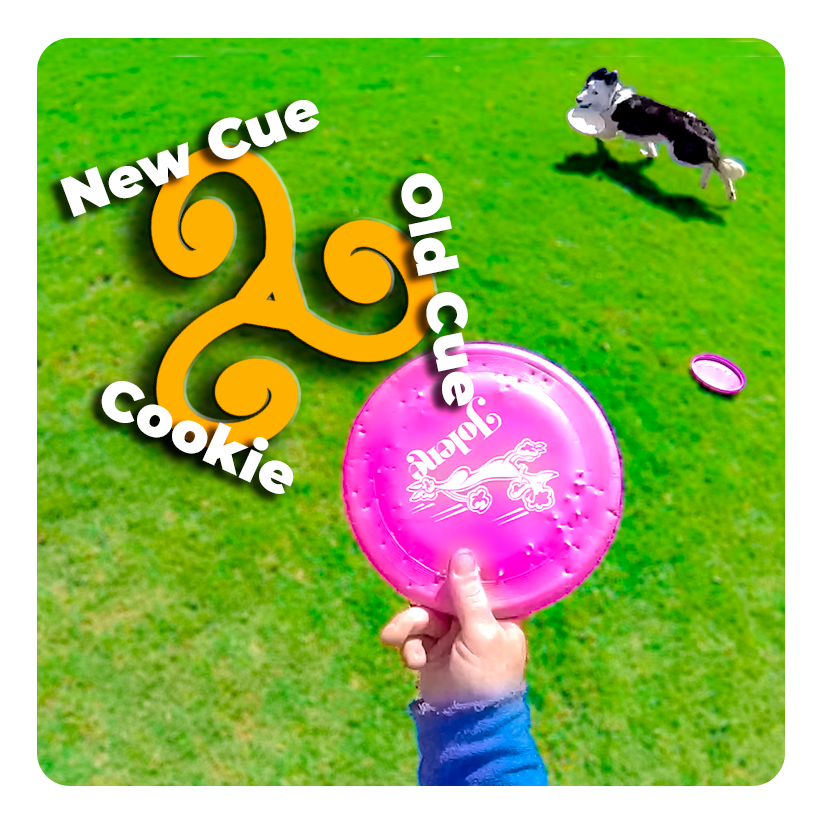Change or Create Cues From Collected Intelligence

New Cue – The Weak Cue That Does Not Work
start with the New Cue (cue that does not work or Weak Cue). offer it and then directly follow by the Strong Cue and the cookie. the New Cue and the Old Cue are paired together and we’re relying on the Old Cue or the cue that works to make the behavior happen.
I’m using New/Weak/Cue that Does Not Work interchangeably, largely because they are interchangeable situations, or situations where each of these phrasings of the unconditioned stimulus actually matter.
When the New Cue which has no meaning consistently precedes an established conditioned stimulus like an old cue or an unintentional cue noticed during play that New Cue gains some meaning. It gives the dog prophetic information about the future. The dog will start to anticipate that signal and then rely on it.
You will know when the dog starts relying on it when the dog starts to perform the skill on the New Cue before you can even start the Old Cue. When the dog starts relying on it doesn’t mean the Dog | Handler | Team know it. Keep that in mind.
Old Cue – The Strong Cue That Actually Works
if you identify a signal that reliably triggers a behavior, that is a Strong Cue, it is a signal that actually works. simply put a New Cue in front of it, give the Strong Cue that makes it happen. and Wait. 10 skillful reps later the New Cue will be gospel.
This is so bad ass, can’t even express it. The key is to present the New Cue -> Old Cue as a simple function – not loaded with your desire to get the behavior, not loaded with emotion, just “New Cue” -> [Strong Cue] and wait. The dog will comply and you can toss a cookie. This is working the Prompt Switch from the Operant Conditioning end of the training spectrum. Where we are giving cookies FOR behaviors performed.
The Prompt Switch also works on the Classical End of the dog training spectrum. In this modality, the cookie is what makes the behavior happen. This is the main application in DiscDog, and might be in dog sports in general haven’t thought about it enough, but might be…
When working on the Classical end you are pairing the Weak Cue with a cue that elicits the behavior and you let the cookie do the talking. No markers, just New Cue – Old Cue – Cookie. The cookie delivery will pull the dog into the behavior. It doesn’t matter. Let the crude classical conditioning, that crude pairing work. In Classical Conditioning the cookie often creates the behavior and the pairing of the cue with the cookie creates an associative relationship to the cue.
Cookie – Am I Going Classical or Consequent
classical or consequent is a key question for the Prompt Switch, and it must be clearly answered from session to session. it is of critical importance to keep the Classical and Operant approaches separate on a session by session basis.
With the Prompt Switch the authority with which you throw the cookies matters. Your confidence in the situation matters. It matters because we’re breaking the rules, from the Dog and Team’s perspective. It must be clear that you, the handler are in charge and know what you’re doing. It’s cool if you don’t. Just fake it. Your dog will buy it long enough for you to get good at it and then you’ll be able to handle it.
For disc work, we’ll be working Classical most of the time, primarily on the cued Drop. Just pair the verbal Drop cue with your throw. Verbal -> Throw in direct succession. Repeat that until the dog is dropping before you can start the throw. Once you notice that Drop happening on your verbal, do a few more sessions with pairing then come out with the intent to pay the dog for Dropping on cue. Give that a shot.
It can’t be stressed enough that the Classical – pairing of cue… cookie – is worked separately from consequent – cue… teeth off/yes!… cookie. If you let them bleed together at all the Prompt Switch won’t work and it will teach exactly the opposite lesson.



